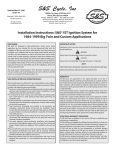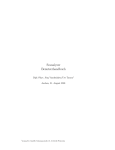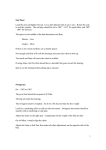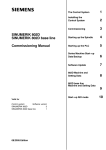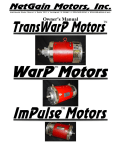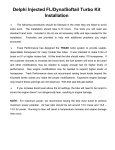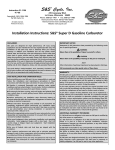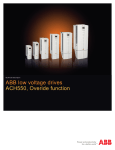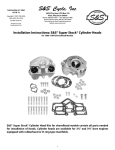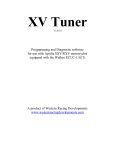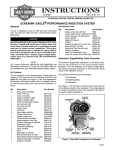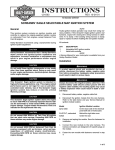Download 750040 - Zodiac
Transcript
S&S Cycle, Inc. ® Instruction 51-1155 4-13-06 Copyright® 2003, 2006 by S&S Cycle, Inc. All rights reserved. Printed in the U.S.A. 235 Causeway Blvd. La Crosse, Wisconsin 54603 Phone: 608-627-1497 • Fax: 608-627-1488 Technical Service Phone: 608-627-TECH (8324) Technical Service Email: [email protected] Website: www.sscycle.com Because every industry has a leader Installation Instructions: S&S® Ignition System for 1984-’99 41⁄8” Bore Big Twin Engines DISCLAIMER: IMPORTANT NOTICE: S&S parts are designed for high performance, off road, racing applications and are intended for the very experienced rider only. The installation of S&S parts may void or adversely effect your factory warranty. In addition such installation and use may violate certain federal, state, and local laws, rules and ordinances as well as other laws when used on motor vehicles used on public highways, especially in states where pollution laws may apply. Always check federal, state, and local laws before modifying your motorcycle. It is the sole and exclusive responsibility of the user to determine the suitability of the product for his or her use, and the user shall assume all legal, personal injury risk and liability and all other obligations, duties, and risks associated therewith. Statements in this instruction sheet preceded by the following words are of special significance. The words Harley®, Harley-Davidson®, H-D®, Sportster®, Evolution®, and all H-D part numbers and model designations are used in reference only. S&S Cycle is not associated with Harley-Davidson, Inc. SAFE INSTALLATION AND OPERATION RULES: Before installing your new S&S part it is your responsibility to read and follow the installation and maintenance procedures in these instructions and follow the basic rules below for your personal safety. ● Gasoline is extremely flammable and explosive under certain conditions and toxic when inhaled. Do not smoke. Perform installation in a well ventilated area away from open flames or sparks. ● If motorcycle has been running, wait until engine and exhaust pipes have cooled down to avoid getting burned before performing any installation steps. ● Before performing any installation steps disconnect battery to eliminate potential sparks and inadvertent engagement of starter while working on electrical components. ● Read instructions thoroughly and carefully so all procedures are completely understood before performing any installation steps. Contact S&S with any questions you may have if any steps are unclear or any abnormalities occur during installation or operation of motorcycle with a S&S part on it. WARNING Means there is the possibility of injury to yourself or others. CAUTION Means there is the possibility of damage to the part or motorcycle. NOTE Other information of particular importance has been placed in italic type. S&S recommends you take special notice of these items. WARRANTY: All S&S parts are guaranteed to the original purchaser to be free of manufacturing defects in materials and workmanship for a period of twelve (12) months from the date of purchase. Merchandise that fails to conform to these conditions will be repaired or replaced at S&S’s option if the parts are returned to us by the purchaser within the 12 month warranty period or within 10 days thereafter. In the event warranty service is required, the original purchaser must call or write S&S immediately with the problem. Some problems can be rectified by a telephone call and need no further course of action. A part that is suspect of being defective must not be replaced by a Dealer without prior authorization from S&S. If it is deemed necessary for S&S to make an evaluation to determine whether the part was defective, a return authorization number must be obtained from S&S. The parts must be packaged properly so as to not cause further damage and be returned prepaid to S&S with a copy of the original invoice of purchase and a detailed letter outlining the nature of the problem, how the part was used and the circumstances at the time of failure. If after an evaluation has been made by S&S and the part was found to be defective, repair, replacement or refund will be granted. ● Consult an appropriate service manual for your motorcycle for correct disassembly and reassembly procedures for any parts that need to be removed to facilitate installation. ADDITIONAL WARRANTY PROVISIONS: ● Use good judgement when performing installation and operating motorcycle. Good judgement begins with a clear head. Don't let alcohol, drugs or fatigue impair your judgement. Start installation when you are fresh. (2) S&S shall have no obligation if an S&S part becomes defective in whole or in part as a result of improper installation, improper maintenance, improper use, abnormal operation, or any other misuse or mistreatment of the S&S part. ● Be sure all federal, state and local laws are obeyed with the installation. ● For optimum performance and safety and to minimize potential damage to carb or other components, use all mounting hardware that is provided and follow all installation instructions. (3) S&S shall not be liable for any consequential or incidental damages resulting from the failure of an S&S part, the breach of any warranties, the failure to deliver, delay in delivery, delivery in non-conforming condition, or for any other breach of contract or duty between S&S and a customer. ● Motorcycle exhaust fumes are toxic and poisonous and must not be inhaled. Run motorcycle in a well ventilated area where fumes can dissipate. (4) S&S parts are designed exclusively for use in Harley-Davidson® and other American v-twin motorcycles. S&S shall have no warranty or liability obligation if an S&S part is used in any other application. (1) S&S shall have no obligation in the event an S&S part is modified by any other person or organization. 1 Instruction Contents: A. Introduction B. Parts List C. Removal of Existing Ignition Module D. S&S® System Installation E. Initial Starting and Operation Procedure F. Basic Troubleshooting G. Advanced Troubleshooting A. Introduction The Intelligent Spark Technology system uses a sophisticated computerized ECU module that integrates data from sensors that other ignition systems are not designed to use. The S&S system makes use of crank position sensor, cam position sensor if present, MAP sensor, cylinder head temperature sensor, and an exclusive knock sensor that actually detects detonation or knock while the engine runs. The knock sensor allows the ECU to automatically adjust ignition timing to eliminate knock whenever it occurs. In addition, the system "remembers" the conditions that cause the engine to knock and automatically adjusts ignition timing to prevent it when those conditions reoccur. On the other hand, when conditions allow for increased ignition timing, the system will advance timing as far as possible without causing the engine to knock. In effect, the system "learns" the ignition requirements of a particular engine and writes a custom ignition map for it. This results in optimized power and fuel economy, as well as reduced emissions. If ignition requirements change, if a lower grade of fuel is introduced, for example, the system will automatically make the necessary ignition timing changes to avoid detonation and possible engine damage. This feature is particularly important in touring applications where the rider sometimes has less control over fuel quality. If a different camshaft is installed, or if cylinder head modifications are made, the S&S Intelligent Spark the ignition timing for the new configuration. Even if major engine modifications are made, such as the installation of a stroker or big bore kit, the system will adjust to the ignition requirements of the engine. Additional features: ● Simple installation – installation kits plug into stock wiring harness. ● No timing adjustments – the system adjusts timing automatically. ● 7000 rpm rev limiter. ● Single fire operation – requires two coils or dual coil package. ● High output – Automatically maximizes coil output. ● Automatic dwell adjust – will optimize current for any coil 0.5 to 3 ohms. ● Short circuit and reverse polarity protected. ● Diagnostics – scan tool or harness jumper. 2 NOTE - The electronics used in the S&S Ignition System require operation in single fire mode only. The S&S Ignition System cannot be used in dual fire mode. Dual Fire vs. Single Fire Ignition Systems Two Types of ignition systems have been used on HarleyDavidson® motorcycles, either dual fire, or single fire. Dual Fire Dual fire ignitions fire the spark plugs in both cylinders on every stroke, each time the pistons reach the tops of the cylinders. One piston is at the top of the compression stroke, while the other piston is near the top of the exhaust stroke. Dual fire is also known as "wasted spark" because the second spark fires near the top of the exhaust stroke. Dual fire was common for many years because it is simplicity and reliability. Dual fire has a slightly rougher idle than single fire because the "wasted" spark occurred just after the top of the exhaust stroke of the rear cylinder, disrupting the incoming intake charge. Single Fire Single fire ignitions fire the spark plugs on every other stroke of the engine, only at the top of the compression stroke. One cylinder fires, then after one crankshaft revolution, the other cylinder fires. A single fire ignition system allows the ignition to reliably transmit more power to the coil during the compression stroke when it is needed most. Ignition Coil Identification Dual Fire Coil In addition to the spark plug terminals, an aftermarket dual fire coil will have two wiring terminals: positive, negative. CAUTION Do not use a dual fire coil with the S&S ignition module. Single Fire Coil In addition to the spark plug terminals, an aftermarket single fire coil will have three wiring terminals: A negative terminal for the front cylinder, a common 12v + terminal, and negative terminal for the rear cylinder, this is the most common type of single fire coil. All single fire coils are compatible with the S&S ignition if they have a resistance of 0.5 to 3 ohms. The standard rating for and aftermarket single fire coil is 3 ohms. Coils with higher resistance will decrease ignition output. k j i h c S&S® Intelligent Spark Technology ECU Module l m d e g n b f a Picture 1 The S&S® Ignition system will also support a variety of different ignition coil combinations as long as they are connected for single fire operation, and yield a final resistance of 0.5 to 3 ohms. The ignition is also compatible dual plug heads with the correct coil configuration. Examples of custom coil/spark plug combinations supported by the S&S ignition: * One coil single fire for single plug heads * One coil single fire for dual plug heads. * Two coil single fire for single plug heads. * Two coil single fire for dual plug heads. Spark Plugs and Plug Wires Spark plugs must be resistor spark plugs (suppression type) of the correct style and heat range for the application. Do not use non-resistor plugs Spark plug wires must be suppression type. Do not use solid metal core plug wires. B. Parts List Picture 2 S&S Ignition System Installation Kit 55-1050 contains the following items (See Picture 1): ● ● ● ● ● ● ● 4 1⁄8” Bore Engine Wiring Harness Adapter (S&S 55-1048). Item (a) Cylinder Head Temperature Sensor (S&S 55-1014, Harley-Davidson® #32446-99). Item (b) Crank Position Sensor (S&S 55-1051, H-D ® #32798-00) and Hardware. Item (c) MAP Sensor (S&S 55-1037, H-D® 32316-99) and Hardware. Item (d) 41⁄8” Bore Coil Harness (S&S 55-1038). Item (e) Loctite® and Wire Ties. Item (f) Knock Sensor Kit (Includes: Knock Sensor, Knock Sensor Mount and Related Hardware S&S 55-1015). Items (g-n) C. Removal of Existing Ignition Components 1. Ignition Module a. Locate the ignition module installed on your motorcycle. The ignition module can usually be found under the seat, a side cover, or in front of the engine on the frame. See Picture 3. Refer to the service manual for your motorcycle if you have trouble locating it. The S&S Ignition Installation Kit for 41⁄8” bore (S&S 55-1050 See Picture 1) is intended only for installation of S&S Intelligent Spark Technology (IST) Ignition Module (S&S 55-1013 See Picture 2). All reference to Harley-Davidson® part numbers is for identification purposes only. We in no way are implying that any of S&S® Cycle’s products are original equipment parts or that they are equivalent to the corresponding HarleyDavidson® part number shown. Picture 3 3 Picture 4 b. Remove the module mounting hardware and unplug the module See Picture 4. The plug is disconnected by simultaneously pressing the locking tabs on the connector and pulling it away from the module. Save the mounting hardware for installation of the S&S® ignition module. 2. D. S&S System Installation CAUTION Be careful not to damage the front of the tank when raising or removing it. Existing Coil, VOES, and Cam Position Sensor a. If so equipped, remove the existing dual fire ignition coil. This is usually located on the left side near the upper motor mount, above the engine front rocker box, or to the left of the engine near the seat. Remove or insulate the "+" and module terminals in the existing harness with heat shrink. Although it may not be necessary in some cases, removal of the gas tank is recommended for ease of installation of the Engine Temperature Sensor, the Knock Sensor Assembly, the Manifold Absolute Pressure (MAP) Sensor and to allow routing of the wiring harness. An alternative to complete tank removal: Loosen (do not remove) the bolt at the front of the tank and remove the mounting bolt(s) at the rear of the tank. The rear of the tank may then be raised slightly to allow enough room to install these components. b. If so equipped, remove the existing vacuum operated electrical switch (VOES). This is located between the heads. Remove or insulate the terminals and connector in the existing harness with heat shrink. NOTE - Clearances are limited at the front of the tank. Use care not to damage any painted surfaces while handling tank. c. 4 Picture 5 Normally 41⁄8” bore engines do not use Cam Position Sensors. If so equipped, remove the two screws, gasket, and the plate covering the Sensor cavity. See Picture 5. Remove the two ignition timing screws and the sensor. See Picture 6. Remove the screw and cup from the end of the camshaft. Reinstall the plate and two screws over the sensor cavity. Remove or insulate the terminals and connector in the existing harness with heat shrink. Picture 6 Installing components without removing the fuel tank is a timesaving suggestion only. If there is any reservation on the part of the installing mechanic about performing this installation with the fuel tank in place, refer to the appropriate service manual for correct procedure for removing fuel tank and related components. 1. Installation of the 41⁄8" Bore Engine Cylinder Head Temperature Sensor. The Cylinder Head Temperature Sensor for 41⁄8" bore engine mounts in a boss found on the front head of all 41⁄8" bore engine equipped motorcycles. a. Install the Head Temperature Sensor. b. Tighten the sensor to 10-12 ft-lbs using a deep well socket and a torque wrench. See Picture 7. Picture 7 2. Installation of the Knock Sensor Kit CAUTION ● Knock Sensor must be mounted to the rear cylinder for correct operation. ● Mounting the Knock Sensor on the front cylinder will provide an incorrect signal. NOTE - There are two mounting locations possible for the knock sensor. Read description of each location, and then examine your motorcycle for which one to use. The first location has better clearance than the second location, the knock sensor will work well in either one. Location 1: Rear cylinder head, across from the temperature sensor on the front head. Some S&S® heads have an unused threaded hole in the rear head near the intake port. If the extra threaded hole is present, install the Knock Sensor there. See Step a below. If the threaded hole is not present, use Location 2. Picture 8 Location 2: Top motor mount at the rear cylinder head attachment point. All stock heads and some early S&S heads do not have the unused, threaded hole across from the temperature sensor, and must use the top motor mount location. See Step b below. a. Knock sensor mounting at Location 1: Rear cylinder head 1. Remove the plug from the rear head. 2. Insert the 5/16 x 11/2" coarse thread bolt (l) through the Knock Sensor and 1/4" thick spacer (h). 3. Attach this assembly to the rear head and torque to 11 ft. lb. See Picture 8. b. Knock sensor mounting at Location 2: Top motor mount location. 1. Remove rear motor mount bolt from rear cylinder head. 2. Test fit Knock Sensor Mounting block to rear motor mount location using 3/8" x 2" coarse thread bolt (k) and 3/8" lockwasher (n). Test fit Knock Sensor to mounting block (i) using bolt (j) and lockwasher (m) See Picture 9. Picture 9 5 CAUTION Carefully place fuel tank back into position to check Knock Sensor and mounting block clearance. Position the mounting block so that the Knock Sensor or mounting block does not contact the fuel petcock or any other part of the motorcycle. If the wiring harness or outer body of the Knock Sensor (black plastic portion) contacts the engine or any other part of the motorcycle, it could damage the Knock Sensor, or interfere with its ability to detect knock. 3. After determining final position for Knock Sensor, remove mounting bolts and lockwashers, then re-install them on mounting block bolt (k), torque to 33 ft- lbs., and Loctite® Red 262 on knock sensor bolt (j), torque to 11 ft-lbs. Picture 10 Do not use the motorcycle’s existing coil harness - a coil harness is provided. c. Primary coil resistance should be in the range of 0.5 to 3 ohms. b. CAUTION Hold knock sensor in position by hand only while torquing. Do NOT use pliers. Damage to knock sensor will occur. 5. Installation of the Crank Position Sensor a Remove the two screws, cover plate, and gasket from the front of the engine crankcase near the oil filter. See Picture 10. b. Install the Crank Position Sensor. Install the supplied 1/4” bolt and torque to 8-10 ft-lb. NOTE - Red Loctite® is not recommended for fasteners into aluminum. 3. Installation of the MAP Sensor a. Replace the existing VOES vacuum hose with the one provided. Trim the hose to a length that will locate the MAP Sensor so it does not interfere with the engine Temperature or Knock sensors, or motor mount hardware. A hose length in the 1 to 2 inch range is acceptable. If the vacuum fitting in the intake manifold is used for other equipment, the line may be cut near the manifold, and the supplied tee may be used. The total line length from the manifold to the sensor should be kept less than 9 inches shorter if practical. b. Remove the orange rubber seal at the end of the MAP Sensor with a pair of needle nose pliers. c. Attach the MAP Sensor to the hose. It is recommended to use wire ties around vacuum hose connections. 4. Installation of the Ignition Coil a. A dual single-fire coil may be installed in the location where the wasted-spark coil was. It should have front and rear connections which go to the module and front and rear spark plug wire connections. Other single fire coils may be used by modifying the supplied harness. 6 6. Installation of the IST Ignition Module and 41⁄8” Bore Wiring Harness Adapter: The 41⁄8" Bore Engine Wiring Harness Adapter (See Picture 11.) is a one-piece assembly consisting of the following connectors: ● (a) IST Ignition Module Connector: 32-Socket, Gray (Delphi®/Packard) - Connects to the S&S® Intelligent Spark Technology Ignition Module. ● (b) Motorcycle Main Harness Connector: 8-socket Black (Deutsch) – Connects to the stock HarleyDavidson® wiring harness in place of the stock module. (c) Head Temperature Sensor Connector: 2-Socket black (Delphi®/Packard) ● Wire Color Main Stripe Coil Terminal Designation White Black Battery "+" Yellow Blue Rear Cylinder Blue Orange Front Cylinder ● (d) Knock Sensor Connector: 2-Socket black (Bosch) ● (e) MAP Sensor Connector: 3-Socket (Delphi®/Packard) ● ● ● b c (f) Coil Harness Connector: 3-Socket black (Delphi®/Packard) (g) Crank Position Sensor Connector: 2-Socket black (Deutsch) d f e g a (h) Data Link Connector with Plug: 4-Pin gray (Deutsch) h Picture 11 The IST ignition module includes a hardware packet. The hardware is intended for spacing the module and the connector off of the mounting back plate. Washers are also included for the mounting screws. This hardware is only necessary on some models. The hardware packet includes the following spacers and washers: ● ● ● ● .200" Spacers (2) .060" Spacers (4) .475" O.D. Washers (2) .250 I.D. Lockwashers (2) NOTE - Locking tabs on each connector listed should produce a light "click" sound when properly assembled. S&S® recommends checking each connection by lightly pulling on each half of the connector to insure that the locking tabs have properly seated. a. Route the wiring harness along the bike frame to ensure that the Ignition Module Connector (a) See Picture 11 reaches the Module mounting location. b. Connect the Ignition Module Connector (a) See Picture 11 to the Module. Picture 12 c. Install the module using the stock mounting hardware and the S&S hardware (if necessary) included with the module. d. Plug the 8-pin black plug from the stock wiring harness into the black 8-socket Motorcycle Main Harness Connector (b) on the S&S harness.See Picture 11 (if the motorcycle plug has only seven pins see step D-7) e. The remaining portion of the harness that connects to the Head Temperature Sensor, MAP Sensor, and the Knock Sensor should be routed along with the stock wiring under the gas tank. f. Use the provided wire ties to secure this portion of the harness to the motorcycle frame or a portion of the existing harness. Do not allow any harness to touch cylinder or head fins which get very hot. g. Connect the Head Temperature Connector (c) See Picture 11, Knock Sensor Connector (d) See Picture 11, and MAP Sensor (e) See Picture 11 to the corresponding sensors. Picture 13 7 7. Motorcycles with a 7-pin ignition connector instead of an 8-pin connector Some Harley-Davidson® motorcycles manufactured between the years 1991 and 1994 had a 7 pin connector in place of the 8-pin connector. A 7 to 8 pin adapter is available through aftermarket sources such as Drag Specialties, and Custom Chrome. It is a universal adapter that allows many different ignition systems (including the S&S IST ignition) to work on motorcycles with a 7-pin connector. If the IST installation is on a motorcycle with a 7-pin connector, an adapter can be purchased separately. Picture 13 NOTE - If the tank is removed or raised, temporarily replace it to insure clearance for the Engine Temperature, MAP, and Knock Sensor portions of the harness. Reroute any wires that may be damaged by installing the tank. NOTE - If using an 7 to 8 pin adapter plug, the IST power harness adapter is not used. 8. IST power harness adapter The IST wiring harness adapter allows installation of the IST ignition on SSW+ engines in custom, carbureted applications. h. Route the main harness segment (f) (See Picture 11) on the S&S® harness to the coil. The table shows the wire color codes that should be matched to the ignition coil. Install each ring terminal under the corresponding screw. Do not allow the screws or ring terminals to touch each other or any other metal. See Picture 12. i. Route the main harness segment (g) (See Picture 11) on the S&S harness to the Crank Position Sensor and attach the connector. Avoid routing this wire segment near coils or spark plug wires. j. Locate main harness segment (h) (See Picture 11) on the S&S harness so that it may be easily accessed by a scantool to check any fault codes that may occur. See Picture 13. k. Permanently reinstall tank, reconnect battery (positive cable first) and any other portions of the motorcycle that have been removed or disconnected. NOTES ● If the IST Ignition will be installed on an 41⁄8" bore engine in a motorcycle with an existing 8-pin ignition connector, the IST main harness connects to it, and the power harness is not used. ● If the motorcycle has an existing connector for an ignition rotor sender, it is not used. 41⁄8" bore engine uses crank position sender instead of nosecone mounted unit. 9. IST power harness adapter connections The power harness adapter (#55-1540) Is used when installing the IST ignition on an 41⁄8" bore engine used in a custom application. It has an 8-pin connector that plugs into the matching connector of the Main IST harness. The power harness 8-pin connector has three wires coming out of it: chassis ground, switched ignition power (battery +), and tachometer signal. Only two connections to the motorcycle are required for the ignition system to operate: chassis ground, and switched ignition power (battery +). The tachometer trigger wire is optional. See Picture 13, and wiring diagram. a. Connect the power harness into IST ignition system, making any corrections in wiring lengths by cutting and splicing using supplied connectors. 8 NOTES ● Installer to source appropriate wire for any additions. use supplied shrink tube and wire cover to insulate and protect wires and connections. ● Stagger any splices in a wire harness bundle. This reduces the chance of wear between adjacent splices. It also makes it easier to pass splices wire through the harness sleeving. ● Crimp connections are preferred over soldered connections. Soldering causes stress concentrations at the wire to solder joint. Soldered connections are prone to break in high vibration environments. In most cases, the switched ignition power connection is made in the wire leading from the ignition switch to the coil. ● If not using a tach, the tach signal wire may be removed from the connector. Note position of connector lock. Pin #1 Pin #2 Picture 15 2. Initial Operating Procedure E. Initial Starting and Operation Procedure: Because the S&S® Intelligent Spark Technology Ignition System is designed to "learn" the specific engine/motorcycle configuration it is being used for, the following initial starting and operating procedures must be followed after installing the system for the first time. These procedures need to be followed only once. After that, the motorcycle can be started and ridden as usual. 1. Initial Starting Procedure CAUTION Damage to coil may result if Steps (a) thru (c) below are not followed! a. After installation is complete, disconnect the coil connector on the S&S main harness. See Picture 11. b. Crank engine with spark plugs removed for approximately 5 seconds. c. Leave the ignition switch on for approximately 5 seconds to allow the ignition system to "learn" the specific motorcycle application for which it is installed. d. After performing Steps 1-3, reinstall spark plugs and reconnect coil. Initially, the S&S Intelligent Spark Technology Ignition System operates using a standard ignition-timing map that may not be optimum but is considered "safe" for most engine configurations. After 3 to 5 hours of operation, with the engine warmed up, the IST Ignition System will have adjusted the map to create one that is optimized for the particular engine configuration. The IST system will continually adapt to subsequent changes in riding style, fuel quality, weather conditions and elevation to further optimize the ignition map. For this reason, data recorded using a chassis dynomometer should be measured after the system has had sufficient time to learn the specific engine parameters. Ride your motorcycle as you normally would during this initial "learning" period. The IST system will learn and adapt the ignition map to various conditions as they are encountered – so the more riding you do, the more the system will fine tune itself. Below are some suggested practices to help the system quickly create the initial optimized timing map: 1. Allow engine to remain at normal operating temperature for at least an hour. 2. Ride up hills and/or inclines. 3. Ride at highway speeds for at least 20 minutes. When road conditions are safe, briefly (1-2 seconds at a time) open the throttle all the way. 4. Ride through intersections/stretches of road where second and third gear roll-ons are required. d. Ride at highway speeds for at least 20 minutes. When road conditions are safe, briefly (1-2 seconds at a time) open the throttle all the way. e. Ride through intersections/stretches of road where second and third gear roll-ons are required. 9 F. Basic Troubleshooting: Advanced Troubleshooting Below are some suggestions if any problems are encountered with the IST Ignition Module. The S&S® ignition system features advanced selfdiagnostic capabilities. The unit detects operational faults, and stores them as codes in memory. There are two methods of retrieving trouble codes stored in memory. First, by counting Flash Codes, generated by the Check Engine light, (see note) and second, by using a Code Reader (Scantool) connected to the data link connector of the S&S Ignition Wiring Harness. Flash codes allow the mechanic to access the trouble code information without the use of a separate code reader, but are less specific than codes retrieved by a code reader. Steps for using both methods follow. NOTES: 1. Problem: Engine cranks but will not start. Possible solutions: a. Check that the gas tank is full and that the fuel petcock is turned on. b. Check that coil wires (plug and harness) have been reinstalled properly. c. Check that all connections are complete on the Wiring Harness Adapter. d. Check that the coil has been reconnected. 2. Problem: Key power-on switch does not seem to work. Possible solutions: a. Check that the power relay is properly connected on the underside connector. Raising the tank during installation can pull enough on the wire harness to disconnect the power relay. b. Check that the battery has been properly reconnected. c. Check that the 12-pin Black and Grey connectors are connected correctly. A visible check would be to check that the wire colors match from one side to the other. If they do not match, disconnect the connector, rotate it to the correct orientation, and reconnect. 10 ● Motorcycles that have an existing check engine light will use it to read stored codes. For motorcycles without an OEM check engine light, there is an LED on the face of the ignition module that functions as a check engine light, and is used to read stored codes. ● Trouble codes are stored in memory for as long as the fault exists, and for 50 on/off cycles of the key after a fault is corrected. A code reader (Scantool) has code clearing capability, and is the only way to clear trouble codes immediately after a fault has been corrected. If a fault still exists, a new trouble code will be generated. Overview of check engine light operation. Initial start sequence. The check engine light will flash in one of the three ways listed below each time the key is turned "on", and the off/run switch is set to "run" ● ● ● ● If no faults are detected, the IST ignition will turn the check engine light "on" for 4 seconds, then "off". If a fault is present at that time, the check engine light will turn "on" for four seconds, then turn "off" for four seconds, then turn "on" continuously. If a fault has occurred and been corrected within the past 50 key on/off cycles, the check engine light will turn "on" for four seconds, then "off" for four seconds, then "on" for eight seconds, then off. When a fault is detected while the motorcycle is running, a code is stored in memory, and the check engine light comes on continuously. Retrieving and displaying codes using the Check Engine light. a. Turn key and off, and off/run switch to "off" b. Remove seat or side cover to expose the OEM datalink connector, located near the ignition module. c. Remove rubber plug from OEM datalink connector. d. Connect pins "1" and "2" of the datalink connector with a jumper wire. Pins have to remain jumped together during the code retrieval process. CAUTION See Picture 14 for pin locations. Do not cross any other pins except pins 1 & 2. e. Turn key to "on" Set off/run switch to run, but do not start engine. f. The check engine light will flash through its initial start sequence, as described above. g. After the initial sequence of flashes, stored trouble codes will then be sent out as a series of flashes. Trouble codes are stored as two digit numbers. The first digit of the trouble code is equal to the number of times the light flashes. There is then a 1.2 second pause, then the second digit of the trouble code is flashed, the second digit being equal to the number of times the light flashes. After three seconds, if additional codes are stored, they will flash in the same manner as the first, until all codes have been displayed, then the sequence will repeat continuously. If only one code is stored, it will repeat continuously. Example: After flashing the initial start sequence (as described above) there will be a pause, then flash, flash, flash, flash, (1.2 second pause) flash. (3 second pause) sequence repeats. This indicates code 41, meaning there is a problem with the crank position sensor. NOTE - See chart for definitions of fault codes supported by the S&S® ignition module. h. After retrieving codes, turn ignition key and run switch to "off". i. Remove jumper wire and replace datalink connector plug. 11 Retrieving codes using a separate Code Reader (Scantool, Scanalyzer) The S&S® ignition uses OBDII (On Board Diagnostics II) code. This is the same platform used universally by the automotive industry as the standard for diagnosing engine problems. The code reader needs to be configured with a generic OBDII PROM (a programmable read only memory cartridge that plugs into the code reader). For example, if using an OTC or Kent-Moore brand Scanalyzer use the Pathfinder 99 (or newer) PROM. Hardware or software designed for use with HarleyDavidson® motorcycles is not compatible with the S&S ignition system. 12 In addition to the automotive style code reader and OBDII cartridge, an adapter cable is required to connect the SAE J1962 (two rows of eight contacts) connection found on automotive code readers to the motorcycle's data link connector. This cable is not included with the ignition. It is a service item, and can be purchased separately, S&S 55-1550. Code readers are produced by various aftermarket companies, refer to the manufacturers instructions for operation procedures. Check Engine Lamp Code Diagnostic Test Condition (Code Reader Only 12 P0107 MAP sensor open 12 P0108 MAP sensor high 12 P0109 MAP sensor intermittent 14 P0117 Engine Temp sensor voltage low 14 P0118 Engine Temp sensor voltage open 14 P0119 Engine Temp sensor voltage intermittent 71 P0324 Knock sensor low input 72 P0327 Knock sensor high input 41 P0335 Crank Position sensor intermittent 41 P0336 Crank Position sensor synch error 42 P0340 Cam sensor failure 16 P0562 Battery voltage low 16 P0563 Battery voltage high 54 P0603 ECM EEPROM error 24 P1351 Front ignition coil open 24 P1352 Front ignition coil high 25 P1354 Rear ignition coil open 25 P1355 Rear ignition coil high 58 P1607 Ignition Module Board temp low 58 P1608 Ignition Module Board temp high Fault Condition 13 14 41⁄8” BORE 15 41⁄8” BORE 41⁄8” BORE Because every industry has a leader

















